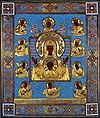- Theotokos of Vladimir
-
The Theotokos of Vladimir (Greek: Θεοτόκος του Βλαντιμίρ), also known as Our Lady of Vladimir or Virgin of Vladimir (Russian: Владимирская Богородица) and "The Vladimir Madonna" - is one of the most venerated Orthodox icons and a typical example of Eleusa Byzantine iconography. The Theotokos (Greek word for Virgin Mary, literally meaning "Birth-Giver of God") is regarded as the holy protectress of Russia. The icon is displayed in the Tretyakov Gallery, Moscow. Her feast day is June 3. Even more than most famous icons, the original has been copied repeatedly for centuries. Many copies now have considerable artistic and religious significance of their own. The icon is a version of the Eleusa (tenderness) type, with the Christ child snuggling up to his mother's cheek.
About 1131 the Greek Patriarch Luke Chrysoberges of Constantinople sent the icon as a gift to Grand Duke Yury Dolgoruky of Kiev. The image was kept in the Mezhyhirskyi Monastery until Dolgoruky's son Andrey Bogolyubskiy brought it to his favourite city, Vladimir, in 1155.[1] Tradition tells that the horses transporting the icon stopped near Vladimir and refused to go further. People interpreted this as a sign that the Theotokos wanted her icon to stay in Vladimir. To house the icon, the great Assumption Cathedral was built there, followed by other churches dedicated to the Virgin throughout Ukraine.
In 1395, during Tamerlane's invasion, the image was taken from Vladimir to the new capital, Moscow. The spot where people and the ruling prince met the icon is commemorated by the Sretensky Monastery. Vasili I of Moscow spent a night crying over the icon, and Tamerlane's armies retreated the same day. The Muscovites refused to return the icon to Vladimir and placed it in the Cathedral of the Dormition of the Moscow Kremlin. The intercession of the Theotokos through the image was credited also with saving Moscow from Tatar hordes in 1451 and 1480.
The icon of the Theotokos of Vladimir is sometimes described as expressing universal feelings of motherly love and anxiety for her child. By the 16th century, the Vladimirskaya (as the Russians call it) was a thing of legend. A pious custom of the church asserted that the icon was painted by St Luke. The venerated image was used in celebration of coronations of tsars, elections of patriarchs, and other important ceremonies of state. In December 1941, as the Germans approached Moscow, Joseph Stalin allegedly ordered that the icon be placed in an airplane and flown around the besieged capital. Several days later, the German army started to retreat.[2]
As a work of art, the Theotokos is widely regarded as the most important icon produced during the Comnenian period. Scholars believe that it expresses deeper humanity and emotionality than that typical of previous Byzantine art. As David Talbot Rice asserts in the latest edition of the Encyclopaedia Britannica, "it is of considerable importance in the history of painting, for it not only is a work of outstandingly high quality but also is in a new, more human style, anticipating the late Byzantine style that flourished between 1204 and 1453."
See also
- Eleusa icon
- Our Lady of Vladimir Church – a church in St. Petersburg, is painted in gold and black, the colours of the Theotokos of Vladimir
- Our Lady of St. Theodore - a miraculous icon said to be painted after the Vladimirskaya
References
- ^ "Kyievo-Mezhyhirksyi Spaso-Preobrazhenskyi Monastyr" (in Ukrainian). Government historical-cultural reserve in the city of Vyshhorod. http://www.vyshgorod-museum.org.ua/index.php?go=News&file=print&id=5. Retrieved 2007-12-27.
- ^ patriarchia.ru
Town-protecting Marian icons of Russia and Ukraine 
National
venerationVladimirskaya (Vladimir and Moscow) · Znamenie (Novgorod) · Smolenskaya (Smolensk) · Feodorovskaya (Kostroma) · Kurskaya (Kursk) · Tolgskaya (Yaroslavl) · Tikhvinskaya (Tikhvin and Northwest Russia) · Kazanskaya (Kazan and all of Russia) 
Regional
venerationList of oldest Russian icons · Iverskaya · Vlakhernskaya · Donskaya · Pochayivska · Kholmska · Derzhavnaya External links
Categories:- Byzantine art
- Russian culture
- Vladimir-Suzdal
- Eastern Orthodox icons of the Virgin Mary
- Visitor attractions in Moscow
Wikimedia Foundation. 2010.


